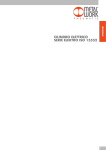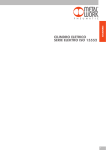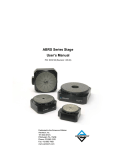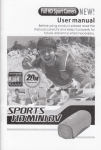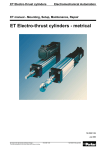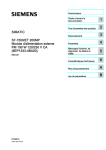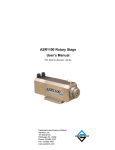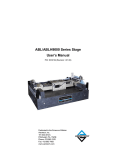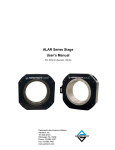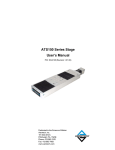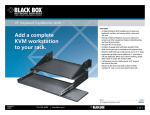Download ARMS Series Stage User`s Manual
Transcript
ARMS Series Stage User’s Manual P/N: EDS135 (Revision 1.02.00) Dedicated to the Science of Motion Aerotech, Inc. 101 Zeta Drive, Pittsburgh, PA, 15238 Phone: 412-963-7470 Fax: 412-963-7459 www.aerotech.com Product Registration Register online at: http://www.aerotech.com/prodreg.cfm Technical Support United States Headquarters: Phone: (412) 967-6440 Fax: (412) 967-6870 Email: [email protected] United Kingdom: Phone: +44 118 940 9400 Fax: +44 118 940 9401 Email: [email protected] Germany: Phone: +49 911 967 9370 Fax: +49 911 967 93720 Email: [email protected] Japan: Phone: +81(0)47-489-1741 (Sales) Phone: +81(0)47-489-1742 (Service) Fax: +81(0)47-489-1743 Email: [email protected] China: Phone: +852-3793-3488 Email: [email protected] Revision History Revision 1.02.00 April 7, 2011 Revision 1.01.00 March 2, 2011 Revision 1.00.00 December 10, 2008 Product names mentioned herein are used for identification purposes only and may be trademarks of their respective companies. © Aerotech, Inc. 2011 ARMS Series Stage User's Manual Table of Contents Table of Contents Table of Contents List of Figures List of Tables iii v vii Chapter 1: Overview 1 1.1. Standard Features 1.1.1. Optional Features 1.1.2. Model Numbers 1.2. Dimensions 1.2.1. ARMS-150 1.2.2. ARMS-150-LD 1.2.3. ARMS-200 1.2.4. ARMS-200-LD 1.2.5. ARMS-260 1.2.6. ARMS-260-LD 1.3. Safety Procedures and Warnings 1.4. EC Declaration of Incorporation Chapter 2: Installation 2.1. Unpacking and Handling the Stage 2.2. Preparing the Mounting Surface 2.3. Securing the Stage to the Mounting Surface 2.4. Attaching the Payload to the Stage 2.5. Electrical Installation Chapter 3: Operating Specifications 3.1. Environmental Specifications 3.2. Basic Specifications 3.3. Load Capability 3.4. Slip Ring Noise Specifications 3.5. Rotary Union 3.6. Limit Switch Wiring 3.7. Standard Motor Wiring 3.8. Vacuum Operation Chapter 4: Maintenance 4.1. Service and Inspection Schedule 4.1.1. Field Service 4.2. Cleaning and Lubrication 4.2.1. Recommended Cleaning Solvents 1 1 2 4 4 5 6 7 8 9 10 12 13 13 14 15 17 17 19 19 20 23 27 27 27 28 29 31 31 31 31 31 Appendix A: Warranty and Field Service 33 Appendix B: Technical Changes 35 Index 37 Reader's Comments 39 www.aerotech.com iii Table of Contents iv ARMS Series Stage User's Manual www.aerotech.com ARMS Series Stage User's Manual List Of Figures List of Figures Figure 1-1: Figure 1-2: Figure 1-3: Figure 1-4: Figure 1-5: Figure 1-6: Figure 1-7: Figure 2-1: Figure 2-2: Figure 2-3: Figure 3-1: Figure 3-2: Figure 3-3: Figure 3-4: Figure 3-5: Figure 3-6: Figure 3-7: ARMS-260 Rotary Stages ARMS-150 Dimensions ARMS-150-LD Dimensions ARMS-200 Dimensions ARMS-200-LD Dimensions ARMS-260 Dimensions ARMS-260-LD Dimensions Results of Flat Versus Non-Flat Mounting Top View of an ARMS-260 Stage Showing Mounting Holes Side View of an ARMS-260 Stage Showing Tapped Mounting Holes Load Orientations ARMS-150-12 Cantilevered Load Capability ARMS-150-37 Cantilevered Load Capability ARMS-200-56 Cantilevered Load Capability ARMS-200-80 Cantilevered Load Capability ARMS-260-100 Cantilevered Load Capability ARMS-260-146 Cantilevered Load Capability www.aerotech.com 1 4 5 6 7 8 9 14 15 16 23 23 24 24 25 25 26 v List of Figures vi ARMS Series Stage User's Manual www.aerotech.com ARMS Series Stage User's Manual List of Tables List of Tables Table 1-1: Table 3-1: Table 3-2: Table 3-3: Table 3-4: Table 3-5: Table 3-6: Table B-1: Table B-2: Model Numbering System Environmental Specifications ARMS Series Specifications ARMS Motor Specifications Slip Ring Noise Specifications Standard Wiring Connectors for ARMS-200MP, -250MP, and -300MP Stages Motor Wiring Pinout Descriptions Current Changes (1.02.00) Archived Changes www.aerotech.com 2 19 21 22 27 28 29 35 36 vii List of Tables viii ARMS Series Stage User's Manual www.aerotech.com ARMS Series Stage User's Manual Overview Chapter 1: Overview This chapter introduces standard and optional features of the ARMS stages, explains the model numbering system, and gives general safety precautions. 1.1. Standard Features All ARMS stages include a direct drive brushless motor. The ARMS is designed to provide superior angular rates, accelerations, and positioning for the testing of inertial components and systems such as MEMS, gyroscopes and accelerometers. The direct drive design is optimum for continuous production environments due to the maintenance free design of the motor. ARMS stages use a 1 Vpp sine wave output feedback device. The stage design also creates outstanding velocity and positioning control. Low inertia and zero backlash make the ARMS the ideal solution for applications requiring frequent directional changes. 1.1.1. Optional Features ARMS stages can incorporate a center aperture. For ARMS-150 and –200, the aperture is 8mm in diameter. For ARMS-260, the aperture is 25mm in diameter. However, apertures are not available for stages requiring a rotary union or a low noise slip ring. The tabletops can be built with either metric or English hole patterns, and the tabletop size can be either standard diameter or large diameter. The mounting holes are designed for metric screws on a metric pattern. The hole patterns are 125mm SQ, 170mm SQ, and 230mm SQ, respectively, for the ARMS-150, ARMS-200, and ARMS-260. Two motor size options are available for each stage size, depending on torque requirements. Multiple slip ring and rotary union options are also available for each stage size. Figure 1-1: www.aerotech.com ARMS-260 Rotary Stages Chapter 1 1 Overview ARMS Series Stage User's Manual 1.1.2. Model Numbers The stage model number indicates the optional features on a particular stage. To determine the options on your stage, refer to Table 1-1 for an explanation of the numbering system. Example: ARMS-260-M-146-RTAS-SRNG48-RU2 This designates an ARMS-260 direct-drive rotary motion simulator with 146 N-m (108 ft-lb) motor, standard diameter tabletop with metric-dimension mounting pattern and engraved marking every 1°, standard feedback device of 1 Vpp sine wave output and 32,400 cycles per rev, 48 line slip ring, and 2 rotary union lines. Aerotech continually improves its product offerings, and listed options may be superseded at any time. Refer to the most recent edition of the Aerotech Motion Control Product Guide for the most current product information at www.aerotech.com. Table 1-1: Model Numbering System ARMS Series Rotary Motion Simulator ARMS-150-X-12 Direct-drive rotary motion simulator with 12 N-m (9 ft-lb) motor ARMS-150-X-37 Direct-drive rotary motion simulator with 37 N-m (28 ft-lb) motor ARMS-200-X-56 Direct-drive rotary motion simulator with 56 N-m (41 ft-lb) motor ARMS-200-X-80 Direct-drive rotary motion simulator with 80 N-m (59 ft-lb) motor ARMS-260-X-100 Direct-drive rotary motion simulator with 100 N-m (74 ft-lb) motor ARMS-260-X-146 Direct-drive rotary motion simulator with 146 N-m (108 ft-lb) motor Mounting and Grid Pattern -M Standard diameter tabletop with engraved markings every 1° and metric-dimension mounting pattern and holes -U Standard diameter tabletop with engraved markings every 1° and English-dimension mounting pattern and holes -MA Standard diameter tabletop with aperture, engraved markings ever 1 ° and metric-dimension mounting pattern and holes -UA Standard diameter tabletop with aperture, engraved markings ever 1 ° and English-dimension mounting pattern and holes -MLD Large diameter tabletop with metric-dimension mounting pattern and holes -ULD Large diameter tabletop with English-dimension mounting pattern and holes -MLDA Large diameter tabletop with aperture and metric-dimension mounting pattern and holes -ULDA Large diameter tabletop with aperture and English-dimension mounting pattern and holes Position Transducer -RTAS 2 Standard feedback device; 1Vpp sine wave output; 32,400 cycles per rev on ARMS-260, 23,600 cycles per rev on ARMS-200; 16,200 cycles per rev on ARMS-150 Chapter 1 www.aerotech.com ARMS Series Stage User's Manual Overview Table 1-1: Model Numbering System (continued) Slip-Ring Circuit Options -SRNG12 12 lines rated at 2 A max (ARMS-150 and –200 only) -SRNG24 24 lines rated at 2 A max -SRNG36 36 lines rated at 2 A max (ARMS-200 only – no aperture option) -SRNG48 48 lines rated at 2 A max (ARMS-260 only) -SRNG56 56 lines rated at 2 A max (ARMS-200 only – no aperture option) -SRNG72 72 lines rated at 2 A max (ARMS-260 only) -SRNG96 96 lines rated at 2 A max (ARMS-260 only) -SRNG12LN 12 low electrical noise lines rated at 1 A max (ARMS-150 and –200 only – no aperture option -SRNG24LN 24 low electrical noise lines rated at 2 A max (1 A max on ARMS-150 and –200 – no aperture option) -SRNG30LN 30 low electrical noise lines rated at 1 A max (ARMS150 and –200 only – no aperture option) -SRNG48LN 48 low electrical noise lines rated at 2 A max (ARMS-260 only – no aperture option) -SRNG70LN 70 low electrical noise lines rated at 2 A max (ARMS-260 only – no aperture option) -SRNG90LN 90 low electrical noise lines rated at 2 A max (ARMS-260 only – no aperture option) Rotary Union Options -NRU No rotary union lines -RU1 1 rotary union line for air, vacuum, or fluid at 250 psi max (no aperture option) -RU2 2 rotary union lines for air, vacuum, or fluid at 250 psi max (no aperture option) www.aerotech.com Chapter 1 3 Overview ARMS Series Stage User's Manual 1.2. Dimensions 1.2.1. ARMS-150 Figure 1-2: 4 ARMS-150 Dimensions Chapter 1 www.aerotech.com ARMS Series Stage User's Manual Overview 1.2.2. ARMS-150-LD Figure 1-3: www.aerotech.com ARMS-150-LD Dimensions Chapter 1 5 Overview ARMS Series Stage User's Manual 1.2.3. ARMS-200 Figure 1-4: 6 ARMS-200 Dimensions Chapter 1 www.aerotech.com ARMS Series Stage User's Manual Overview 1.2.4. ARMS-200-LD Figure 1-5: www.aerotech.com ARMS-200-LD Dimensions Chapter 1 7 Overview ARMS Series Stage User's Manual 1.2.5. ARMS-260 Figure 1-6: 8 ARMS-260 Dimensions Chapter 1 www.aerotech.com ARMS Series Stage User's Manual Overview 1.2.6. ARMS-260-LD Figure 1-7: www.aerotech.com ARMS-260-LD Dimensions Chapter 1 9 Overview ARMS Series Stage User's Manual 1.3. Safety Procedures and Warnings The following statements apply throughout this manual. Failure to observe these precautions could result in serious injury to those performing the procedures and damage to the equipment. This manual and any additional instructions included with the stage should be retained for the lifetime of the stage. To minimize the possibility of electrical shock and bodily injury or death, disconnect all electrical power prior to making any electrical connections. To minimize the possibility of electrical shock and bodily injury or death when any electrical circuit is in use, ensure that no person comes in contact with the circuitry when the stage is connected to a power source. To minimize the possibility of bodily injury or death, disconnect all electrical power prior to making any mechanical adjustments. Moving parts of the stage can cause crushing or shearing injuries. All personnel must remain clear of any moving parts. Improper use of the stage can cause damage, shock, injury, or death. Read and understand this manual before operating the stage. If the stage is used in a manner not specified by the manufacturer, the protection provided by the stage can be impaired. Stage cables can pose a tripping hazard. Securely mount and position all stage cables to avoid potential hazards. 10 Chapter 1 www.aerotech.com ARMS Series Stage User's Manual Overview Do not expose the stage to environments or conditions outside the specified range of operating environments. Operation in conditions other than those specified can cause damage to the equipment. The stage must be mounted securely. Improper mounting can result in injury and damage to the equipment. Use care when moving the stage. Manually lifting or transporting stages can result in injury. Only trained personnel should operate, inspect, and maintain the stage. This stage is intended for light industrial manufacturing or laboratory use. Use of the stage for unintended applications can result in injury and damage to the equipment. Before using this stage, perform an operator risk assessment to determine the needed safety requirements. www.aerotech.com Chapter 1 11 Overview ARMS Series Stage User's Manual 1.4. EC Declaration of Incorporation Manufactorer: Aerotech, Inc. 101 Zeta Drive Pittsburgh, PA 15238 USA herewith declares that the product: Aerotech, Inc. ARMS Stage is intended to be incorporated into machinery to constitute machinery covered by the Directive 2006/42/EC as amended; does therefore not in every respect comply with the provisions of this directive; and that the following harmonized European standards have been applied: EN ISO 12100-1,-2:2003+A1:2009 Safety of machinery - Basic concepts, general principles for design ISO 14121-1:2007 Safety of machinery - Risk assessment - Par 1: Principles EN 60204-1:2005 Safety of machinery - Electrical equipment of machines - Part 1: General requirements and further more declares that it is not allowed to put the equipment into service until the machinery into which it is to be incorporated or of which it is to be a component has been found and declared to be in conformity with the provisions of the Directive 2006/42/EC and with national implementing legislation, i.e. as a whole, including the equipment referred to in this Declaration. Authorized Representative: Address: Manfred Besold AEROTECH GmbH Süd-West-Park 90 D-90449 Nürnberg Name: Position: Location: Date: 12 Alex Weibel / Engineer Verifying Compliance Pittsburgh, PA April 7, 2011 Chapter 1 www.aerotech.com ARMS Series Stage User's Manual Installation Chapter 2: Installation This chapter describes the installation procedure for the ARMS stage, including handling the stage properly, preparing the mounting surface, securing the stage to the mounting surface, attaching the payload, and making the electrical connections. Installation must follow the instructions in this chapter. Failure to follow these instructions could result in injury and damage to the equipment. 2.1. Unpacking and Handling the Stage Carefully remove the stage from the protective shipping container. Blow the stage off with compressed nitrogen or clean, dry air. Before operating the stage, it is important to let the stage stabilize at room temperature for at least 12 hours. Set the stage on a smooth, flat, and clean surface. Each stage has a label listing the system part number and serial number. These numbers contain information necessary for maintaining or updating system hardware and software. Locate this label and record the information for later reference. If any damage has occurred during shipping, report it immediately. Improper stage handling could adversely affect the stage’s performance. Use care when moving the stage. Manually lifting or transporting the stage can cause injury. Lift the stage only by the base. Do not use the tabletop or wiring connections to support the stage. www.aerotech.com Chapter 2 13 Installation ARMS Series Stage User's Manual 2.2. Preparing the Mounting Surface The mounting surface should be flat and have adequate stiffness in order to achieve the maximum performance from the ARMS. When a stage is mounted to a non-flat surface, the stage can be distorted as the mounting screws are tightened. This distortion will decrease the overall accuracy of the stage. To maintain accuracy, the mounting surface should be flat within 1µm per 50mm. Adjustments to the mounting surface must be done before the stage is secured. The effects of flatness on mounting are illustrated in Figure 2-1. Figure 2-1: Results of Flat Versus Non-Flat Mounting N O T E : The stage base is precision machined and verified for flatness prior to stage assembly at the factory. If machining is required to achieve the desired flatness, it should be performed on the mounting surface rather than the stage base. Shimming should be avoided if possible. If shimming is required, it should be minimized to improve the rigidity of the system. 14 Chapter 2 www.aerotech.com ARMS Series Stage User's Manual Installation 2.3. Securing the Stage to the Mounting Surface ARMS series stages have numerous mounting holes available to secure the stage to a mounting surface. Figure 2-2 shows the main mounting holes in the base of the stage. These counterbored holes are designed for M6 or M8 socket head cap screws, depending on the stage size. The sides of the stage are also equipped with several M6 x 1.0 tapped holes with reinforced threaded inserts. These can be used for stage or fixture mounting, depending on customer requirements. The stage must be mounted securely. Improper mounting can result in injury and damage to the equipment. Figure 2-2: www.aerotech.com Top View of an ARMS-260 Stage Showing Mounting Holes Chapter 2 15 Installation ARMS Series Stage User's Manual Figure 2-3: 16 Side View of an ARMS-260 Stage Showing Tapped Mounting Holes Chapter 2 www.aerotech.com ARMS Series Stage User's Manual Installation 2.4. Attaching the Payload to the Stage To prevent damage to the stage or parts, test the operation of the stage before any payload is mounted to the stage tabletop. Proceed with the electrical installation and test the motion control system in accordance with the system documentation. Document all results for future reference. For information on electrical connections, refer to the documentation of the motion control system or the wiring drawings in Chapter 3: Operating Specifications. 2.5. Electrical Installation Aerotech motion control systems are adjusted at the factory for optimum performance. When the ARMS series stage is part of a complete Aerotech motion control system, setup involves connecting the stage to the appropriate drive chassis with the cables provided. Connect the provided cables to the feedback and motor connectors shown in Figure 1-1. Labels on the drive indicate the appropriate connections. Refer to your drive manuals and documentation for additional installation and operation information. In some cases, if the system is uniquely configured, a drawing showing system interconnects is supplied. Connector pin outs for the feedback and motor connectors are given in Section 3.7. Never connect or disconnect any electrical component or connecting cable while power is applied, or serious damage may result. The stage's protective ground is located on pin A4 of the motor connector. If you are using cables other than those provided by Aerotech, you must connect pin A4 to a ground connection. www.aerotech.com Chapter 2 17 Installation 18 ARMS Series Stage User's Manual Chapter 2 www.aerotech.com ARMS Series Stage User's Manual Operating Specifications Chapter 3: Operating Specifications This chapter contains general technical information about ARMS series stages. Included are basic product specifications, resolution information, and motor wiring diagrams. 3.1. Environmental Specifications The environmental specifications for the ARMS are listed in the following table. Table 3-1: Environmental Specifications Ambient Temperature Operating: 10° to 35° C (50° to 95° F) The optimal operating temperature is 20° C ±2° C (68° F ±4° F). If at any time the operating temperature deviates from 20° C degradation in performance could occur. Contact Aerotech for information regarding your specific application and environment. Storage: 0° to 40° C (32° to 104° F) in original shipping packaging Humidity Operating: 40 percent to 60 percent RH The optimal operating humidity is 50 percent RH. Storage: 30 percent to 60 percent RH, non-condensing in original packaging Altitude Operating: 0 to 2,000 m (0 to 6,562 ft) above sea level Contact Aerotech if your specific application involves use above 2,000 m or below sea level. Vibration Use the system in a low vibration environment. Excessive floor or acoustical vibration can affect stage and system performance. Contact Aerotech for information regarding your specific application. Dust Exposure The ARMS stages are not suited for dusty or wet environments. This equates to an ingress protection rating of IP30. Use Indoor use only Do not expose the stage to environments or conditions outside the specified range of operating environments. Operation in conditions other than those specified can cause damage to the equipment. www.aerotech.com Chapter 3 19 Operating Specifications ARMS Series Stage User's Manual 3.2. Basic Specifications The ARMS series rotary stage specifications are shown in Table 3-2. 20 Chapter 3 www.aerotech.com ARMS Series Stage User's Manual Table 3-2: Operating Specifications ARMS Series Specifications ARMS Series Width ARMSARMS150-12 150-37 146 mm Height (1) 183 mm 246 mm Aperture(2) ARMSARMS200-56 200-80 196 mm ARMSARMS260-100 260-146 260 mm 224 mm 229 mm 249 mm 8 mm Total Travel ±360° Continuous Motor Continuous Current, Stall S-130-39A S-130102-A S-180-69A S-180-94A S-240-63A S-240-83A Apk 3.8 3.1 5.1 4.9 5.9 5.8 Arms 2.7 2.2 3.6 3.5 4.2 4.1 11.7 N-m 37.4 N-m 55.6 N-m 80.0 N-m 100 N-m 146 N-m 2.8 N-m 9.2 N-m 13.7 N-m 19.9 N-m 24.9 N-m 36.5 N-m Bus Voltage Up to 320 VDC Peak Torque Continuous Torque Resolution Fundamental Encoder Resolution 0.04-4 arc-sec 0.03-3 arc-sec 0.02-2 arc-sec 16,200 lines/rev 23,600 lines/rev 32,400 lines/rev Accuracy (calibrated) ±2.5 arc-sec Repeatability ±0.5 arc-sec Max Load (3) Axial Moment 30 kg 140 kg 230 kg 175 N-m 425 N-m 650 N-m Wobble Maximum Rate 250 mm 25 mm ±1 arc-sec (4) 1500°/s Minimum Rate (5) Rate Resolution 0.002°/s (5) Rate Stability (5) Peak Acceleration 0.001°/s 0.002°/s 0.001°/s Over 360° 0.0001% Over 10° 0.005% Over 1° 0.05% (6) Inertia (unloaded) (6) Total Mass (6) >20,000°/s2 6,600 kgmm2 9,700 kgmm2 33,600kgmm2 39,800 kg-mm2 115,200 kg-mm2 139,000 kg-mm2 9 kg 15 kg 22 kg 26 kg 39 kg 44 kg Servo Bandwidth (7) > 70 Hz (-3 dB) Material Aluminum Stage Finish Tabletop Finish Black Anodize Hard Coating (62 Rockwell Hardness) (1) Height may vary with certain slip ring and rotary union options. See product dimensional drawings for more details. (2) Aperture not available with all slip ring and rotary union options. See ordering information for more details. (3) Maximum loads are mutually exclusive. (4) Maximum rate is based on stage capability. Actual rate may depend on encoder resolution, load, amplifier bus voltage, and motor. See the S-series rotary motor for more information. (5) Minimum rate, rate resolution, and rate accuracy are based on stage capability. Actual rate, resolution, and accuracy may depend on encoder resolution. (6) Peak acceleration, inertia, and total mass based on unloaded stage with standard diameter tabletop. (7) Servo bandwidth is based on unloaded stage with standard diameter tabletop. Actual bandwidth may depend on mass and inertia of stage payload. www.aerotech.com Chapter 3 21 Operating Specifications Table 3-3: ARMS Series Stage User's Manual ARMS Motor Specifications Model Winding Designation S-13039 S-130102 S-18069 S-18094 S-24063 S-24083 -A -A -A -A -A -A Performance Specifications (1,5) Stall Torque, Continuous (2) N-m 2.36 7.69 11.12 15.93 19.71 29.09 in-lb 20.9 68.1 98.4 141.0 174.4 257.5 N-m 9.42 30.75 44.47 63.70 78.82 116.37 in-lb 83.4 272.2 393.7 563.9 697.8 1030.1 rpm 2,000 500 500 250 250 200 watts 493.4 402.5 582.1 416.9 515.9 609.3 Volts pk / krpm 75.1 300.2 263.9 393.4 404.3 607.2 Amp pk 3.8 3.1 5.1 4.9 5.9 5.8 Peak Torque (3) Rated Speed Rated Power Output, Continuous Electrical Specifications (5) BEMF Constant (line to line, max) Continuous Current, Stall (2) Amp rms 2.7 2.2 3.6 3.5 4.2 4.1 Peak Current, Stall (3) Amp pk 15.2 12.4 20.4 19.6 23.6 23.2 Amp rms 10.7 8.8 14.4 13.9 16.7 16.4 N-m / Amp pk 0.62 2.48 2.18 3.25 3.34 5.02 in-lb / Amp pk 5.5 22.0 19.3 28.8 29.6 44.4 N-m / Amp rms 0.88 3.51 3.08 4.60 4.72 7.09 in-lb / Amp rms 7.8 31.0 27.3 40.7 41.8 62.8 N-m / √W 0.265 0.710 1.053 1.391 1.405 1.893 in-lb / √W 2.35 6.29 9.32 12.31 12.43 16.76 ohms 5.6 12.5 4.4 5.6 5.8 7.2 Inductance (line to line) mH 1.70 3.67 1.70 2.60 2.90 4.30 Maximum Bus Voltage VDC 340 340 340 340 340 340 °C / W 0.95 0.64 0.67 0.57 0.38 0.32 P 18 18 18 18 26 26 Torque Constant (4,9) Motor Constant (2,4) Resistance, 25 °C (line to line) Thermal Resistance Number of Poles (1) Performance is dependent upon heat sink configuration, system cooling conditions, and ambient temperature (2) Values shown @ 75 °C rise above a 25 °C ambient temperature, with housed motor mounted to a 330 mm x 330 mm x 13 mm aluminum heat sink (3) Peak torque assumes correct rms current, consult Aerotech (4) Torque Constant and Motor Constant specified at stall (5) All performance and electrical specifications +/- 10% (6) Losses due to bearings and aerodynamics considered negligible (7) Maximum winding temperature is 100 °C, Thermistor trips at 100 °C (8) Ambient operating temperature range: 0 °C - 25 °C, consult Aerotech for performance in elevated ambient temperatures (9) All Aerotech amplifiers are rated Apk; use torque constant in N-m / Apk when sizing 22 Chapter 3 www.aerotech.com ARMS Series Stage User's Manual Operating Specifications 3.3. Load Capability It is recommended that application loads be symmetrically distributed whenever possible (i.e., the payload should be centered on the stage table and the entire stage should be centered on the support structure). With the stage lying flat (horizontal) and the application load vertically applied and symmetrically distributed, the maximum vertical load carrying capacity of the ARMS stages can be seen in the following figures. Cantilevered loads are also referred to in these figures. For cantilevered loads, it must first be determined if the stage is loaded axially or radially. See Figure 3-1 to determine. Figure 3-1: Figure 3-2: www.aerotech.com Load Orientations ARMS-150-12 Cantilevered Load Capability Chapter 3 23 Operating Specifications 24 ARMS Series Stage User's Manual Figure 3-3: ARMS-150-37 Cantilevered Load Capability Figure 3-4: ARMS-200-56 Cantilevered Load Capability Chapter 3 www.aerotech.com ARMS Series Stage User's Manual Figure 3-5: Figure 3-6: www.aerotech.com Operating Specifications ARMS-200-80 Cantilevered Load Capability ARMS-260-100 Cantilevered Load Capability Chapter 3 25 Operating Specifications Figure 3-7: 26 ARMS Series Stage User's Manual ARMS-260-146 Cantilevered Load Capability Chapter 3 www.aerotech.com ARMS Series Stage User's Manual Operating Specifications 3.4. Slip Ring Noise Specifications ARMS stages come equipped with a slip ring. Multiple circuit versions are available as well as low noise options. See Table 3-4. Table 3-4: Slip Ring Noise Specifications Option Noise Specification Standard Slip Ring <60 mOhms Low Noise (LN) Slip Ring <10 mOhms 3.5. Rotary Union ARMS stages can come equipped with or without a rotary union option. The rotary union option may have one (1) or two (2) lines for air, vacuum, or fluid. However, no aperture can be ordered with a rotary union. The maximum pressure is 250 psi. 3.6. Limit Switch Wiring Standard ARMS stages do not include end-of-travel limits. Please consult the factory for a custom solution. www.aerotech.com Chapter 3 27 Operating Specifications ARMS Series Stage User's Manual 3.7. Standard Motor Wiring Stages come from the factory completely wired and assembled. For reference, connector pin outputs (pinouts) and general wiring information are given in the following figures. Pinouts are defined in Table 3-6. N O T E : Refer to the other documentation accompanying your Aerotech equipment. Call your Aerotech representative if there are any questions on system configuration. N O T E : If you are using your own cables to connect the stage, ensure that motor and ground wires can handle current higher than the continuous current listed in Table 3-3. The voltage rating of the wire insulation must be greater than the maximum bus voltage listed in Table 3-3. Table 3-5: Standard Wiring Connectors for ARMS-200MP, -250MP, and -300MP Stages Pin Description Pin Description A1 MTR ØA 3 RESERVED A2 MTR ØB 4 RESERVED A3 MTR ØC 5 RESERVED 1 MTR SHLD A4 FRM GND 2 RESERVED Pin Description Pin Description 1 SIG SHLD 14 COS 2 TH+ 15 COS-N 3 ENC +5V 16 LMT +5V 17 SIN SIN-N 4 5 HB 18 6 MKR-N 19 7 MKR 20 LMT COM 8 RESERVED 21 ENC COM 9 22 10 HA 23 11 HC 24 12 25 13 28 Chapter 3 www.aerotech.com ARMS Series Stage User's Manual Table 3-6: Operating Specifications Motor Wiring Pinout Descriptions Pin Output COS Description Cosine. Incremental encoder output; either TTL line driven or amplified sine wave type signal. COS-N Incremental encoder output. Complement of cos. ENC COM + 5 V return for optical encoders (ground). ENC +5V +5 V supply input for optical encoders. Typical requirement is 250 mA. HA Hall Effect A. Brushless motor commutation track output. TTL line driven signal with rotary motor. HB Hall Effect B. Brushless motor commutation track output. TTL line driven signal with rotary motor. HC Hall Effect C. Brushless motor commutation track output. TTL line driven signal with rotary motor. LMT +5v + 5 V supply input for optical limit switch boards. Typical requirement is 50 mA. LMT COM Common ground for limit switch MKR Marker. Incremental encoder output pulse given once per revolution. Typically used for home reference cycle. MKR-N Incremental encoder output; either the compliment of Marker with a line driven, TTL type encoder or 2.5 V DC bias level with amplified sine wave type encoder. SIN Sine. Incremental encoder output; either TTL line driven or amplified sign wave type signal. SIN-N Incremental encoder output. Complement of sin. TH+ Positive lead for motor thermistor (to motion controller) TH- Negative lead for motor thermistor (tied to ground via feedback connector). MTR ØA Motor Phase A. MTR ØB Motor Phase B. MTR ØC Motor Phase C. FRM GND Ground to stage base SIG SHLD Shield for feedback connector MTR SHLD Shield for motor wiring connector 3.8. Vacuum Operation Contact the factory for information regarding operation in a vacuum environment. www.aerotech.com Chapter 3 29 Operating Specifications 30 ARMS Series Stage User's Manual Chapter 3 www.aerotech.com ARMS Series Stage User's Manual Maintenance Chapter 4: Maintenance The ARMS series stages are designed to be maintenance-free positioning systems. Periodic cleaning is recommended. To minimize the possibility of bodily injury, confirm that all electrical power is disconnected prior to making any mechanical adjustments. 4.1. Service and Inspection Schedule It is recommended that the ARMS stage be inspected once per month until a trend develops for the specific application and environment. 4.1.1. Field Service In general, repair and/or replacement of damaged or malfunctioning components of the ARMS stage by Aerotech field service personnel is not possible. Stage repair typically requires that the unit be returned to the factory. Please contact Aerotech Technical Support for more information. 4.2. Cleaning and Lubrication There are no elements of the ARMS series stages that require lubrication. Periodic cleaning is recommended. 4.2.1. Recommended Cleaning Solvents Before using a cleaning solvent on any part of the stage, it is recommended that compressed nitrogen or clean, dry air be used to blow away small particles and dust. Any metal surface of the stage may be cleaned with acetone, followed by isopropyl alcohol. www.aerotech.com Chapter 4 31 Maintenance 32 ARMS Series Stage User's Manual Chapter 4 www.aerotech.com ARMS Series Stage User's Manual Warranty and Field Service Appendix A: Warranty and Field Service Aerotech, Inc. warrants its products to be free from defects caused by faulty materials or poor workmanship for a minimum period of one year from date of shipment from Aerotech. Aerotech's liability is limited to replacing, repairing or issuing credit, at its option, for any products that are returned by the original purchaser during the warranty period. Aerotech makes no warranty that its products are fit for the use or purpose to which they may be put by the buyer, where or not such use or purpose has been disclosed to Aerotech in specifications or drawings previously or subsequently provided, or whether or not Aerotech's products are specifically designed and/or manufactured for buyer's use or purpose. Aerotech's liability or any claim for loss or damage arising out of the sale, resale or use of any of its products shall in no event exceed the selling price of the unit. Aerotech, Inc. warrants its laser products to the original purchaser for a minimum period of one year from date of shipment. This warranty covers defects in workmanship and material and is voided for all laser power supplies, plasma tubes and laser systems subject to electrical or physical abuse, tampering (such as opening the housing or removal of the serial tag) or improper operation as determined by Aerotech. This warranty is also voided for failure to comply with Aerotech's return procedures. Laser Products Claims for shipment damage (evident or concealed) must be filed with the carrier Return Procedure by the buyer. Aerotech must be notified within (30) days of shipment of incorrect materials. No product may be returned, whether in warranty or out of warranty, without first obtaining approval from Aerotech. No credit will be given nor repairs made for products returned without such approval. Any returned product(s) must be accompanied by a return authorization number. The return authorization number may be obtained by calling an Aerotech service center. Products must be returned, prepaid, to an Aerotech service center (no C.O.D. or Collect Freight accepted). The status of any product returned later than (30) days after the issuance of a return authorization number will be subject to review. After Aerotech's examination, warranty or out-of-warranty status will be determined. If upon Aerotech's examination a warranted defect exists, then the product(s) will be repaired at no charge and shipped, prepaid, back to the buyer. If the buyer desires an airfreight return, the product(s) will be shipped collect. Warranty repairs do not extend the original warranty period. Returned Product Warranty Determination After Aerotech's examination, the buyer shall be notified of the repair cost. At such Returned Product time, the buyer must issue a valid purchase order to cover the cost of the repair and Non-warranty Deterfreight, or authorize the product(s) to be shipped back as is, at the buyer's mination expense. Failure to obtain a purchase order number or approval within (30) days of notification will result in the product(s) being returned as is, at the buyer's expense. Repair work is warranted for (90) days from date of shipment. Replacement components are warranted for one year from date of shipment. At times, the buyer may desire to expedite a repair. Regardless of warranty or outof-warranty status, the buyer must issue a valid purchase order to cover the added rush service cost. Rush service is subject to Aerotech's approval. www.aerotech.com Appendix A Rush Service 33 Warranty and Field Service ARMS Series Stage User's Manual On-site Warranty If an Aerotech product cannot be made functional by telephone assistance or by Repair sending and having the customer install replacement parts, and cannot be returned to the Aerotech service center for repair, and if Aerotech determines the problem could be warranty-related, then the following policy applies: Aerotech will provide an on-site field service representative in a reasonable amount of time, provided that the customer issues a valid purchase order to Aerotech covering all transportation and subsistence costs. For warranty field repairs, the customer will not be charged for the cost of labor and material. If service is rendered at times other than normal work periods, then special service rates apply. If during the on-site repair it is determined the problem is not warranty related, then the terms and conditions stated in the following "On-Site Non-Warranty Repair" section apply. On-site Non-warranty If any Aerotech product cannot be made functional by telephone assistance or purRepair chased replacement parts, and cannot be returned to the Aerotech service center for repair, then the following field service policy applies: Aerotech will provide an on-site field service representative in a reasonable amount of time, provided that the customer issues a valid purchase order to Aerotech covering all transportation and subsistence costs and the prevailing labor cost, including travel time, necessary to complete the repair. Company Address Aerotech, Inc. 101 Zeta Drive Pittsburgh, PA 15238-2897 34 Phone: (412) 963-7470 Fax: (412) 963-7459 Appendix A www.aerotech.com ARMS Series Stage User's Manual Technical Changes Appendix B: Technical Changes Table B-1: Current Changes (1.02.00) Section(s) Affected Section 3.7. General Information Changed pin 8 to reserved www.aerotech.com Appendix B 35 Technical Changes Table B-2: 36 ARMS Series Stage User's Manual Archived Changes Revision 1.00.00 Section(s) Affected -- General Information New manual 1.01.00 Section 1.4. Section added 1.01.00 Section 3.1. Section added 1.01.00 Chapter 2: Installation, Section 2.1. , Section 2.3. , Section 2.5. , and Section 1.3. 1.01.00 Section 3.2. Motor specifications added 1.01.00 Section 3.7. Note about wire current and voltage requirements added Safety information and warnings added Appendix B www.aerotech.com Index ARMS Series Stage User's Manual Index R Rotary Union A Attaching the Payload 27 17 S C safety procedures 10 cable 17 Securing the Stage to the Mounting Surface 15 Cleaning 31 Slip Ring 27 Cleaning Schedule 31 Specifications 20 Standard Features Cleaning Solvents Recommended 1 31 U Unpacking and Handling the Stage D Declaration of Incorporation 13 12 V Dimensions 4 Vacuum Operation 29 E W Electrical Installation 17 Environmental Specifications 19 Warnings 10 F Field Service 31 L limit switches 27 Lubrication 31 M model numbers 13 O Optional Features 1 P Preparing the Mounting Surface www.aerotech.com 14 Index 37 ARMS Series Stage User's Manual 38 Index Index www.aerotech.com Reader's Comments ARMS Series Stage Manual P/N: EDS135, April 7, 2011 Revision 1.02.00 Please answer the questions below and add any suggestions for improving this document. Is the manual: Yes No Adequate to the subject Well organized Clearly presented Well illustrated How do you use this document in your job? Does it meet your needs? What improvements, if any, would you like to see? Please be specific or cite examples. Stage/Product Details Name Model # Title Serial # Company Name Date Shipped Address Customer Order # Aerotech Subsidiary Order # Email Mail your comments to: Fax to: Aerotech, Inc. 101 Zeta Drive Pittsburgh, PA 15238 U.S.A. 412-967-6870 Email: [email protected]

















































